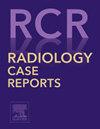胸椎巨细胞瘤:脊髓受压的一个不寻常原因
Q4 Medicine
引用次数: 0
摘要
骨巨细胞瘤(gct)是一种罕见的肿瘤,通常位于长骨干骺端,很少发生在脊柱,特别是在胸椎区域。我们报告的情况下,34岁的妇女牛皮癣和乳糜泻的历史,谁提出了进行性炎性背部疼痛和麻痹。影像学显示在T11椎体有溶骨性肿块,导致脊髓背侧受压。经组织病理学证实为GCT,随即进行了紧急手术。尽管最初运动功能恢复,手术稳定后来是必要的,以防止脊柱不稳定。患者开始接受Denosumab辅助治疗,随访时无症状。这个病例强调了GCT在胸椎的罕见性和相关的诊断和治疗挑战。虽然是良性的,但gct可引起严重的脊髓压迫,需要及时手术干预以保持神经功能。Denosumab治疗在控制肿瘤进展和提高手术效果方面显示出希望。多学科管理和定期随访对预防复发和改善预后至关重要。本文章由计算机程序翻译,如有差异,请以英文原文为准。
Giant cell tumor of the thoracic spine: An unusual cause for spinal cord compression
Giant cell tumors (GCTs) of bone are uncommon neoplasms, typically located in the metaphysis of long bones, with rare occurrences in the spine, especially in the thoracic region. We report the case of a 34-year-old woman with a history of psoriasis and celiac disease, who presented with progressive inflammatory back pain and paraparesis. Imaging revealed an osteolytic mass at the T11 vertebra, causing dorsal spinal cord compression. Emergency surgery was performed, with histopathology confirming GCT. Despite initial recovery of motor function, surgical stabilization was later necessary to prevent spinal instability. The patient was started on adjuvant Denosumab therapy and remained asymptomatic on follow-up. This case highlights the rarity of GCT in the thoracic spine and associated diagnostic and therapeutic challenges. Though benign, GCTs can cause severe spinal cord compression, necessitating prompt surgical intervention to preserve neurological function. Denosumab therapy shows promise in controlling tumor progression and enhancing surgical outcomes. Multidisciplinary management and regular follow-up are essential to prevent recurrence and improve prognosis.
求助全文
通过发布文献求助,成功后即可免费获取论文全文。
去求助
来源期刊

Radiology Case Reports
Medicine-Radiology, Nuclear Medicine and Imaging
CiteScore
1.10
自引率
0.00%
发文量
1074
审稿时长
30 days
期刊介绍:
The content of this journal is exclusively case reports that feature diagnostic imaging. Categories in which case reports can be placed include the musculoskeletal system, spine, central nervous system, head and neck, cardiovascular, chest, gastrointestinal, genitourinary, multisystem, pediatric, emergency, women''s imaging, oncologic, normal variants, medical devices, foreign bodies, interventional radiology, nuclear medicine, molecular imaging, ultrasonography, imaging artifacts, forensic, anthropological, and medical-legal. Articles must be well-documented and include a review of the appropriate literature.
 求助内容:
求助内容: 应助结果提醒方式:
应助结果提醒方式:


